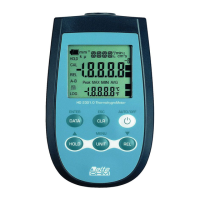- -
11
4. PROBES AND MEASUREMENTS
The instrument HD2301.0R works by using combined humidity/temperature probes (temperature
with a Pt100 sensor or thermocouple K) and with temperature only probes with 4 wire Pt100, or 2
wire Pt1000.
The combined humidity/temperature probes are fitted with SICRAM module that acts as an
interface between the sensor on the probe and the instrument. There is a microprocessor circuit with
a permanent memory inside the module that enables the instrument to recognize the type of probe
connected and to read its calibration information.
The Delta Ohm Pt1000 probes are automatically detected while the direct 4 wire Pt100 temperature
probe is not automatically detected by the instrument and must be set up in the Probe type menu
item (please see the menu description on chapter 3).
Note: temperature/humidity probes having code ended with “R” (p.e. HP472ACR), can be used
with instruments with HD2301.0R code. These probes cannot be used with instruments HD2301.0
(without “R” letter).
The probe is detected during turn on, and this cannot be performed when the instrument is
already on, therefore if a probe is connected and the instrument is on, it is necessary to turn it
off and on.
4.1 MEASUREMENT OF RELATIVE HUMIDITY
The humidity probes are "humidity and temperature" combined probes:
• the humidity sensor is a capacitative type sensor;
• while according to the model the temperature sensor is either a Pt100 or a thermocouple K.
The instrument measures relative humidity %RH and temperature, and starting from the fixed
barometric pressure value of 1013.25mbar it calculates the following resulting quantities:
1. g/m
3
grams of vapour in a cubic meter of dry air
2. hPa Partial vapour pressure (hPa)
3. Td Dew point (°C or °F)
4.1.1 Performing the measurement
To perform the measurement, proceed as follows:
• introduce the probe in the area of whose parameters you wish to measure,
Caution! Keep the probe far from elements that might interfere with measurement such as: heat or
sources of cooling, walls, air-streams, etc.
Avoid temperature drops that might cause condensation.
• a reading taken when no heat drop occurs is practically immediate;
NOTE: in conditions involving heat drops, it is necessary to wait until the probes and their
housing have reached a thermal equilibrium in order to prevent heat irradiation or absorption on the
relative humidity sensor which would cause a faulty measurement.
• since temperature affects relative humidity; move the probe like a fan in order to speed the
response time in the presence of heat drops.

